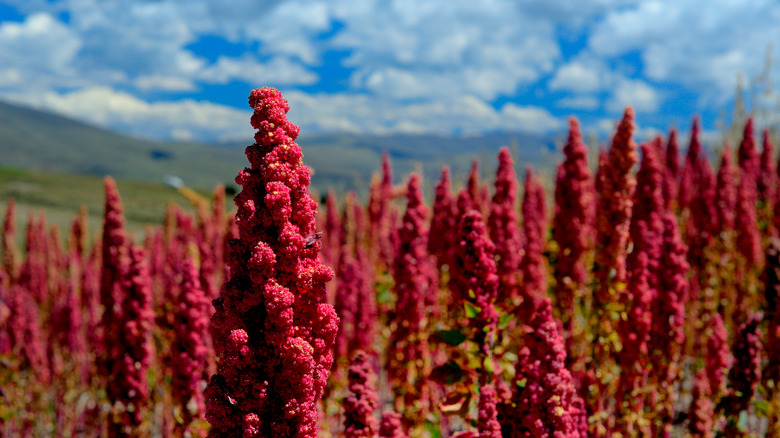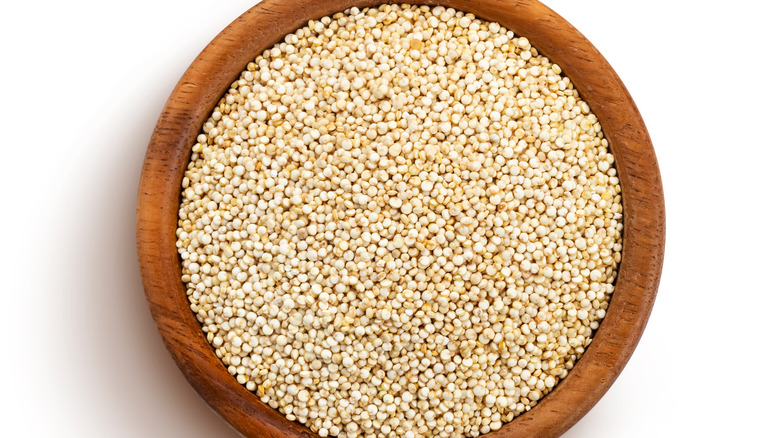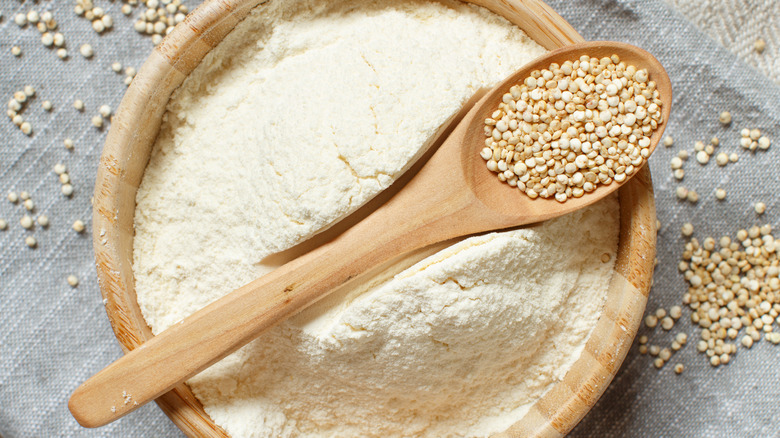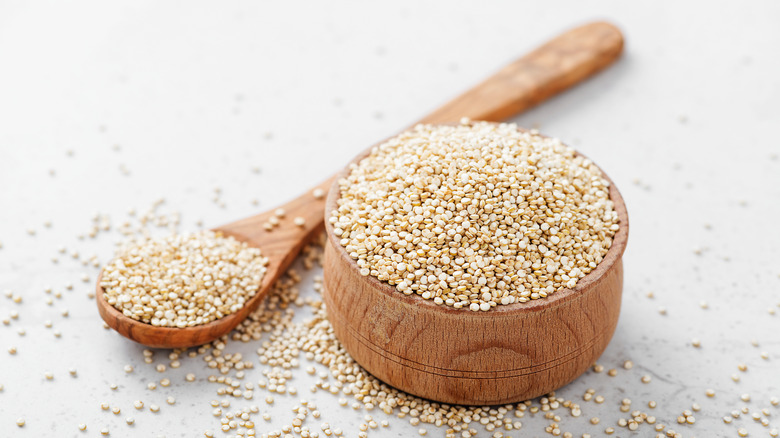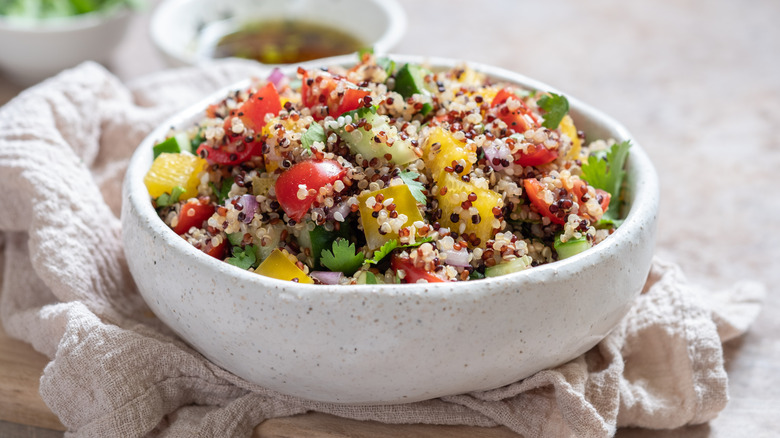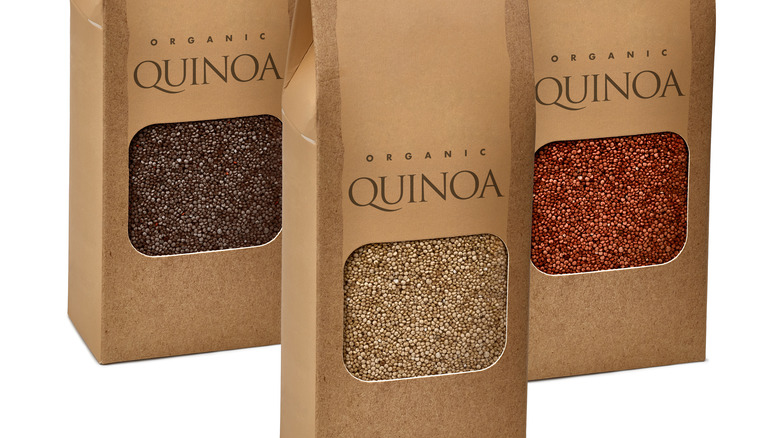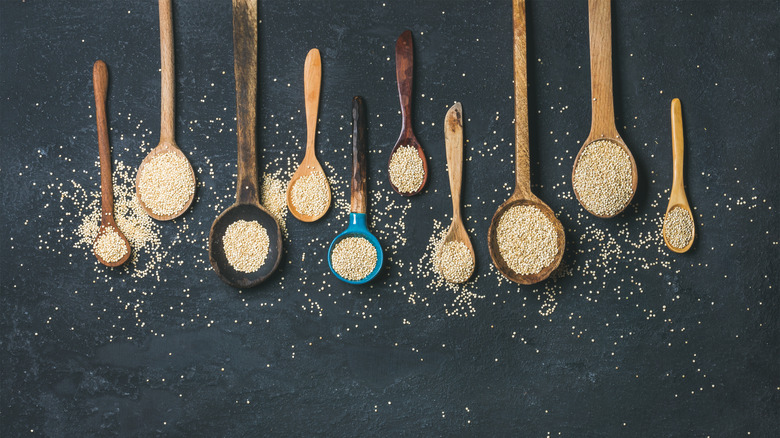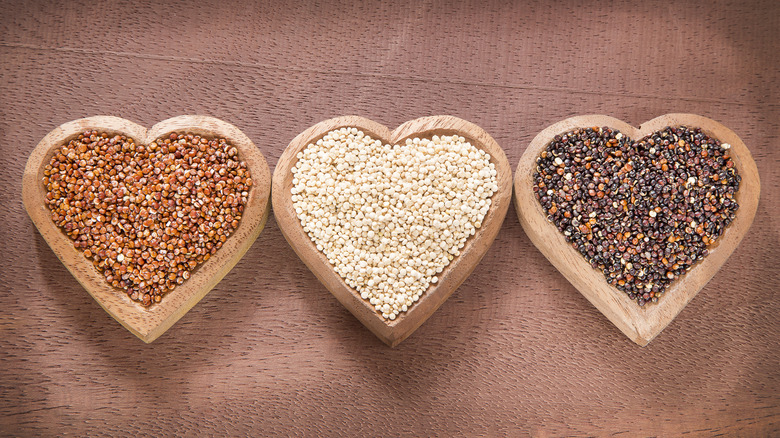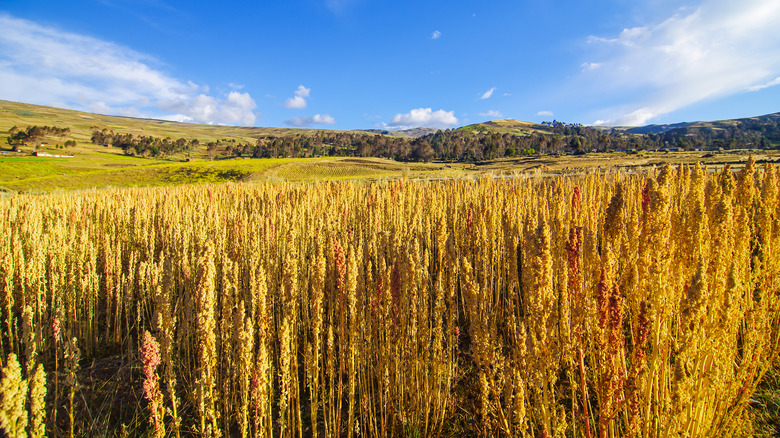What Is Quinoa And Is It Nutritious?
As much as junk food might have a certain appeal, eating a balanced diet can be an efficient path to overall health. Finding nutritious options that are just as appetizing can lead to many culinary discoveries. While some are more recent, others have been around for millenia, praised for their desirable attributes.
Quinoa (Chenopodium Quinoa Willd) is an ancient grain that has been around for over 5,000 years, and shows no sign of abating (via Britannica). Even though it's eaten as a whole grain, Everyday Health explains that quinoa is actually a pseudo-cereal, since the seed comes from a plant, not grass. Grain or not, if you're looking for something akin to a grain that packs in plenty of nutrients and impressive benefits, quinoa is just the food you need. The Food and Agriculture Organization (FAO) of the United Nations even named 2013 the International Year of Quinoa, for its role in global food security.
Quinoa is easy to cook, and has a delicious and unique flavor that pairs well with sweet and savory ingredients. It's also suitable for gluten free diets, and is especially applauded for vegetarians and vegans.
What is quinoa?
There's nothing new about quinoa. It dates back about 5,000 years, originating in South America, particularly in the highlands of Bolivia, Ecuador, Chile, and Peru, according to Harvard. Britannica reports that the seed comes from the goosefoot plant, and is part of the amaranthaceae family which also contains beets, spinach, and chard. The encyclopedia says that the leaves are also nutritious, though you're more likely to find the seeds, which are flat and rounded. Grains & Legumes Nutrition Council describes them as similar in size and color to a sesame seed. However, not all quinoa is pale yellow — it can be found in various colors.
Although quinoa is technically a seed, it is regularly referred to as a grain, even in the Inca Empire, where it was called chisaya mama, or mother of all grains, according to NPR, which explains that the seed was extremely important to the Andean diet. It's equally revered as a superfood thousands of years later. True to its origin, says the Grains & Legumes Nutrition Council, quinoa grows best at higher altitudes and cool climates.
In order to adapt well to high altitude, sun intensity, and pesky birds, the exterior of quinoa seeds are covered in saponin, which acts as a natural insecticide and protects them against the rays of the sun, according to Harvard. While it's beneficial for the plant, the resulting flavor is bitter and soapy and demands you rinse your quinoa thoroughly.
Whole quinoa vs quinoa flakes or flour
In its raw form, quinoa is a small seed that needs to be cooked for consumption. Once it's cooked, it is similar to many whole grains such as rice, couscous, and barley. The resemblance is merely superficial, since quinoa is a seed, not a grain. Nevertheless, when it has been boiled, whole quinoa can be used in salads, pilafs, soups, and stews.
Meanwhile, quinoa can also be purchased as a flake or flour. The flakes are actually just whole seeds that have been rolled and flattened, explains Simply Quinoa. They are a bit less common to find, but are often sold with oats and can be ordered easily online. As a flake, quinoa can be eaten raw, though it won't have much flavor. Simply Quinoa recommends soaking them overnight with milk, fruit, and sweetener, for example. Flakes also add plenty of chewiness to no-bake cookies or granola bars.
Quinoa flour is an excellent gluten-free option that adds a nice texture and nutty flavor to baked goods. Cookies, muffins, pancakes, and bread can all be made using this alternative. If you want to have a go at making it yourself, Simply Quinoa explains you just have to grind dry white quinoa to a fine powder.
What does quinoa taste like?
The Spruce Eats describes quinoa as having a nutty, delicate flavor, with a touch of earthiness. It's more akin to brown rice than white, but packs in more nuttiness overall. Packaged quinoa will often be pre-washed, but nevertheless, The Spruce Eats advises giving the seeds an extra rinse to avoid any unpleasant flavors from the saponins that coat it. Once cooked, the texture is light and fluffy, with a slight chew.
The three main colors of quinoa sold commercially are beige, reddish brown, and black, notes The Spruce Eats. The flavor is stronger as the color of the seed darkens, and the texture is also crunchier. The three colors are often sold as a trio mix, so that you can get a blend of flavors and consistencies.
The flavor of quinoa flakes is much subtler and can easily blend into baked goods, or used to bulk up a smoothie. The seed can also be puffed up like Rice Krispies for a crispy topping. Finally, quinoa flour is regularly used as a gluten-free flour replacement, and Simply Quinoa explains that the natural proteins in the seed contribute to a stretchy texture. It will taste a bit nuttier than all-purpose flour and can add some complexity to your baking. If you find it bitter, Simply Quinoa recommends quickly toasting the flour prior to using it.
How to cook with quinoa
Quinoa is most commonly found as a dry seed which needs to be cooked before consumption. One cup of dried quinoa should give you close to three cups cooked, according to Eating Well. First, rinse the seed in a fine mesh sieve to make sure there's no lingering saponin. The Spruce Eats describes the method of cooking as similar to preparing brown rice or barley. Using a 1:2 ratio of quinoa to water, bring a pot of water with the quinoa to a boil, then simmer for about 15 minutes. The site explains that a tiny white spiral will appear when the quinoa is ready. If there is some excess water, drain it, and using a fork, fluff the quinoa. Eating Well notes that you can also cook the seed in an Instant Pot or rice cooker. White quinoa will cook the fastest and become the softest, whereas red and black varieties will take a bit longer and maintain some crunch (via The Spruce Eats).
Use cooked quinoa anywhere you would eat rice, couscous, or a grain. It's a great option for meal prep, and can be refrigerated for up to five days, or frozen after it's been cooked. It works really well in salads, pilafs, soups, stews, and veggie burgers. Since the flavor is mild and nutty, quinoa can be prepared with sweet or savory ingredients. Try adding a bit of maple syrup, cinnamon, and chopped fruits for a twist on plain old porridge.
Where to buy quinoa
Thankfully, with its popularity in the past decade, quinoa has become increasingly easy to find. The Spruce Eats reports that it can be found in most supermarkets, either in the natural food aisle or together with rice and grains. There are often options for pilaf-style packages of quinoa combined with herbs and spices for a quick, flavor-packed meal. The Spruce Eats remarks that quinoa is expensive compared to grains, but keep in mind that it's far more than just a source of starch. You should have no problem finding quinoa in health food stores or online, either. Bulk stores are also likely to sell it, and may have different colors.
If you're looking for quinoa flakes, Simply Quinoa suggests checking by the cereals, oats, natural foods, or gluten-free ingredients. Similarly, quinoa flour will either be with other flours, natural foods, or gluten-free baking ingredients. As always, a quick search online should also bring up various options for purchase. In the gluten-free section you might also come across quinoa chips, pasta, crackers, and other alternatives to foods commonly made with wheat. (If you see chocolate covered quinoa puffs, don't hesitate to buy them!) All forms of quinoa should be stored sealed in a dry pantry out of direct light.
Nutritional information about quinoa
For such an unsuspecting seed, quinoa certainly has a lot to offer. Since it's a seed, not a grain, it's therefore suitable for gluten-free diets. One of the seed's most impressive qualities is that it is one of few plant-based complete proteins, containing all nine essential amino acids, according to Healthline. Grains & Legumes Nutrition Council affirms that quinoa is composed of 15% protein. This makes it especially valuable for vegans and vegetarians who often struggle to consume complete proteins.
Aside from its admirable protein content, quinoa is also high in fiber, manganese, magnesium, B vitamins, and iron (via Healthline). Verywell Fit reports that one cup of quinoa has eight grams of protein and five grams of fiber, compared to less than one gram of fiber and four grams of protein in white rice, and only a bit more fiber in brown rice. Of course, variety is important in a balanced diet, but it's worth noting that quinoa is undoubtedly nutritionally dense.
Quinoa is also praised for its antioxidant content, which Healthline points out is high in flavonoids, known for their anti-inflammatory, anticancer, and antiviral properties. LiveScience reports that darker quinoa has a higher concentration of nutrients. Healthline also notes that quinoa has a low glycemic index, which assists in blood sugar regulation. While it is not a low-calorie food, the fact that quinoa is nutritionally dense and satiating makes it a suitable choice for balanced weight loss.
Different varieties of quinoa
The Spruce Eats describes white, red, and black quinoa as the most commonly found varieties. However, Harvard notes that there are over 120 varieties of the seed. The university website also tells us that the lighter colors are more mildly flavored and are good starting points if you've never tried quinoa.
White or ivory quinoa also cooks the fastest and is the most versatile, making it a great choice to add into sweet or savory recipes. It also has a nice, tender, fluffy texture which works well to thicken soups or stews. Meanwhile, red and black quinoa have more pronounced, nutty and earthy flavors. They take longer to cook and hold their shape while remaining slightly crunchy. The darker seeds work well in cold salads, since they maintain their bite and add a splash of color. A favorite for many is a trio mix of the three colors, for a bit of fluffiness amid the crunch.
The ethics of quinoa
After 2013 was declared the International Year of Quinoa, the demand for the superfood rose. The Straits Times reports that prices and exports multiplied as farmers tried to fulfill demands. The Guardian writes that quinoa became expensive in Peru, threatening local food security while gracing the plates of vegans and health-conscious consumers on the other side of the continent.
However, The Irish Times notes that quinoa consumption in South America wasn't originally as high as people reported. Farmers seemed to be faring well with their increased business, and could afford to purchase a variety of foods. On the other hand, Economic Students describes that South American diets worsened as they began to replace traditional foods with processed options that had become affordable.
Besides food security, the increase in demand for quinoa led to the crop being farmed as a monoculture, which has detrimental agricultural effects, including erosion and poor soil quality, notes The Guardian. Isabella Falco, the director of Promperu, Peru's export and tourist commission, tells The Straits Times that the most nutritious quinoa is the one grown in its native environment at high altitude.
While it's hard to know what is best in a culture and context different from our own, choosing Fair Trade quinoa or seeds grown in your own country can ensure South American farmers are paid fairly, and do not feel that they can only earn a living by solely focusing on one crop.
